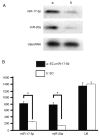The miR-17-92 cluster regulates FOG-2 expression and inhibits proliferation of mouse embryonic cardiomyocytes
- PMID: 22267003
- PMCID: PMC3854259
- DOI: 10.1590/s0100-879x2012007500007
The miR-17-92 cluster regulates FOG-2 expression and inhibits proliferation of mouse embryonic cardiomyocytes
Abstract
MicroRNAs (miRNAs) have gradually been recognized as regulators of embryonic development; however, relatively few miRNAs have been identified that regulate cardiac development. A series of recent papers have established an essential role for the miRNA-17-92 (miR-17-92) cluster of miRNAs in the development of the heart. Previous research has shown that the Friend of Gata-2 (FOG-2) is critical for cardiac development. To investigate the possibility that the miR-17-92 cluster regulates FOG-2 expression and inhibits proliferation in mouse embryonic cardiomyocytes we initially used bioinformatics to analyze 3' untranslated regions (3'UTR) of FOG-2 to predict the potential of miR-17-92 to target it. We used luciferase assays to demonstrate that miR-17-5p and miR-20a of miR-17-92 interact with the predicted target sites in the 3'UTR of FOG-2. Furthermore, RT-PCR and Western blot were used to demonstrate the post-transcriptional regulation of FOG-2 by miR-17-92 in embryonic cardiomyocytes from E12.5-day pregnant C57BL/6J mice. Finally, EdU cell assays together with the FOG-2 rescue strategy were employed to evaluate the effect of proliferation on embryonic cardiomyocytes. We first found that the miR-17-5p and miR-20a of miR-17-92 directly target the 3'UTR of FOG-2 and post-transcriptionally repress the expression of FOG-2. Moreover, our findings demonstrated that over-expression of miR-17-92 may inhibit cell proliferation via post-transcriptional repression of FOG-2 in embryonic cardiomyocytes. These results indicate that the miR-17-92 cluster regulates the expression of FOG-2 protein and suggest that the miR-17-92 cluster might play an important role in heart development.
Figures





Similar articles
-
Identification and analysis of ZFPM2 as a target gene of miR-17-92 cluster in chicken.Yi Chuan. 2017 Apr 20;39(4):333-345. doi: 10.16288/j.yczz.16-425. Yi Chuan. 2017. PMID: 28420612
-
Translational control of FOG-2 expression in cardiomyocytes by microRNA-130a.PLoS One. 2009 Jul 7;4(7):e6161. doi: 10.1371/journal.pone.0006161. PLoS One. 2009. PMID: 19582148 Free PMC article.
-
microRNA-18b modulates insulin-like growth factor-1 expression in deer antler cell proliferation by directly targeting its 3' untranslated region.DNA Cell Biol. 2015 Apr;34(4):282-9. doi: 10.1089/dna.2014.2421. Epub 2015 Mar 10. DNA Cell Biol. 2015. PMID: 25756952 Free PMC article.
-
MicroRNA-17 post-transcriptionally regulates polycystic kidney disease-2 gene and promotes cell proliferation.Mol Biol Rep. 2010 Jul;37(6):2951-8. doi: 10.1007/s11033-009-9861-3. Epub 2009 Oct 10. Mol Biol Rep. 2010. PMID: 19821056
-
miR-106b fine tunes ATG16L1 expression and autophagic activity in intestinal epithelial HCT116 cells.Inflamm Bowel Dis. 2013 Oct;19(11):2295-301. doi: 10.1097/MIB.0b013e31829e71cf. Inflamm Bowel Dis. 2013. PMID: 23899543 Free PMC article.
Cited by
-
The Pleiotropic Role of the MicroRNA-17-92 Cluster in Cardiovascular Diseases and Cancer.Rev Cardiovasc Med. 2025 May 27;26(5):27966. doi: 10.31083/RCM27966. eCollection 2025 May. Rev Cardiovasc Med. 2025. PMID: 40475735 Free PMC article. Review.
-
MiR-92 Family Members Form a Cluster Required for Notochord Tubulogenesis in Urochordate Ciona savignyi.Genes (Basel). 2021 Mar 12;12(3):406. doi: 10.3390/genes12030406. Genes (Basel). 2021. PMID: 33809016 Free PMC article.
-
Discrimination of the expression of paralogous microRNA precursors that share the same major mature form.PLoS One. 2014 Mar 3;9(3):e90591. doi: 10.1371/journal.pone.0090591. eCollection 2014. PLoS One. 2014. PMID: 24594692 Free PMC article.
-
Roles of miR-17-92 Cluster in Cardiovascular Development and Common Diseases.Biomed Res Int. 2017;2017:9102909. doi: 10.1155/2017/9102909. Epub 2017 Jan 10. Biomed Res Int. 2017. PMID: 28164128 Free PMC article. Review.
-
Insights into role of microRNAs in cardiac development, cardiac diseases, and developing novel therapies.Iran J Basic Med Sci. 2020 Aug;23(8):961-969. doi: 10.22038/ijbms.2020.40974.10015. Iran J Basic Med Sci. 2020. PMID: 32952941 Free PMC article. Review.
References
-
- Lee Y, Ahn C, Han J, Choi H, Kim J, Yim J, et al. The nuclear RNase III Drosha initiates microRNA processing. Nature. 2003;425:415–419. - PubMed
Publication types
MeSH terms
Substances
LinkOut - more resources
Full Text Sources
Other Literature Sources
Molecular Biology Databases
Research Materials

